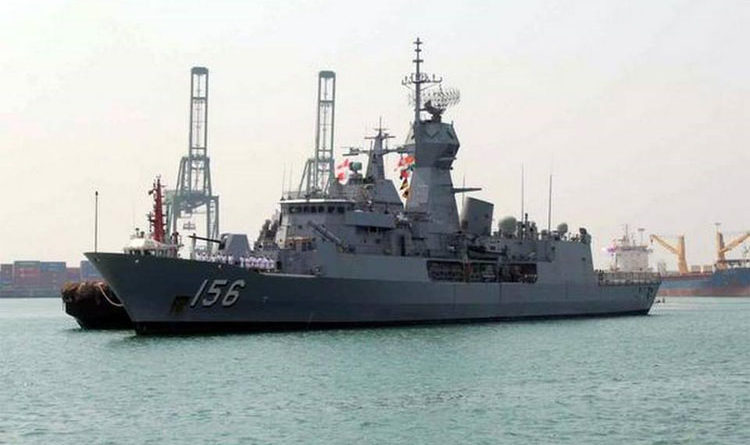Australian Navy Frigate’s Chennai Visit Part Of Canberra’s ‘East Asian Deployment’
May 11, 2019
Australian warship HMAS Toowoomba made a port visit to Chennai in support of Australia’s commitment to engage with Indo-Pacific nations and to promote regional maritime security and cooperation. HMAS Toowoomba was in Chennai between May 10 and 15. Photo: Special Arrangement
HMAS Toowoomba is in Chennai as part of Operation Manitou.
On May 10, HMAS Toowoomba, a frigate of the Royal Australian Navy, docked at Chennai’s port, where it will remain this week as it prepares to continue on its broader mission in the Indian Ocean Region and West Asia. This mission involves counter-terrorism, anti-piracy and broader maritime security imperatives. On the side-lines of an engagement in Chennai, Commander Mitchell Livingstone, who is leading this engagement, spoke to Narayan Lakshman about the surge in military cooperation between New Delhi and Canberra, and why that matters for broader bilateral ties and regional maritime security. They were joined by Australian Defence Advisor Simon Bateman. Edited transcript:
The Toowoomba is in Chennai as part of Operation Manitou. Could you explain the broad contours of the mission?
Mitchell Livingstone: We’re calling this an East Asian deployment, which is basically to improve interoperability with the Indian navy, confirm our combined efforts toward maritime security. We all have a vested interest in the Indian Ocean. It’s a [considerable] distance from India to Australia, but we do share the same waterway, so we’ve all got a vested interest in ensuring that it’s prosperous and secure. As an island nation we’re are highly dependent – our only means [of access] is via the air or the sea. We need to engage regionally to ensure that we benefit and [India] benefits from a secure waterway.
You mentioned interoperability and that reminds us of the COMCASA agreement, signed by India and the United States. Could you give us any insights into the state of play on that subject, between India and Australia?
Mitchell Livingstone: It’s more and more complex, is probably the short version. The serials are improving in complexity, which is great. We’ve gone from ships meeting in the ocean and exchanging pleasantries to ships meeting in the ocean and conducting higher-level tactical evolutions, which is a real step forward.
Simon Bateman: The level of interoperability has gone up substantially. In the most recent AUSINDEX exercise (the third edition of a joint naval exercise undertaken in April 2019, off the coast of Vishakhapatnam), in a war-fighting sense, doing submarine versus submarine serials is at the high end. But then the human end or [the strength of] people-to-people relationships was demonstrated when we had two sick Australian sailors with appendicitis, who were flown off by the Indian navy, and operated on in an Indian navy hospital before sending them back to Australia. Most recently, a submarine on its way back to Australia had another sick sailor, who the Indian navy took to into Port Blair [in the Andaman and Nicobar Islands], where the sailor was looked [after]. With all the requisite clearances coming from the Ministry of Defence, and navy, [this was done] very quickly. That’s a great example of the trust that exists now. So, yes, at the high end, it’s great to see, but I think that sometimes its more important that people-to-people relationships are effective. We can get on the phone and, acknowledging that Port Blair is a restricted area, are able to fly in doctors from Australia, sort this [sick] person out, then [fly them out]. That was a really good example of the interoperability that now exists.
I know there have been several such joint naval exercises in the past few years, and the Quad [quadrilateral cooperation agreement between India, the U.S., Japan and Australia] exists in the backdrop, so how do you see the trajectory of the bilateral space evolving, going forward?
Simon Bateman: We’ve already reached a fairly high level between the two exercises, in terms of the confidence level between the two navies. The decision to open that out to other like-minded [countries] is something that will have to be made at a political level. Countries are often very reticent to give away their bilateral relationship. However, if it becomes a political direction or interest to expand it out, we would look to do that. “Quad” is a word that indicates a quadrilateral relationship between four countries. It doesn’t always have to be the four that everybody leaps to, an example being the Group Sail [through the South China Sea, earlier this week, by India, the U.S., Japan and the Philippines]. We’re always very keen to be a part of a relationship with other like-minded countries including bilaterals, trilaterals, or quadrilaterals, to achieve the aims that we all share.
Could you sketch the landscape of Operation Manitou, what it involves? How much is India involved, or does that bilateral apply more to AUSINDEX?
Mitchell Livingstone: AUSINDEX is a structured, planned, and briefed exercise, with a series of war-fighting objectives, whereas Operation Manitou is an Australian construct, and is us slotting into that broader combined maritime force of 33 contributing nations. We are just one of those 33. We’ve been doing this for nearly 30 years so it’s part of our stock-in-trade. We see the Indian navy in the region. We don’t necessarily interact with them as part of the combined maritime force construct, but we certainly could. There are no real limiting constraints to prohibit their interaction. It’s probably a bigger U.S.-coalition decision about their direct involvement, but certainly, ship-on-ship, there’s nothing prohibiting that interaction.
Courtesy: The Hindu

